Michigan chestnut crop report for the week of June 20, 2024
Black stem borer is still active. Asian chestnut gall wasp emergence is imminent in infested orchards in southern Michigan.
Weather review
Over the last month, most regions of Michigan have been 2 – 4 degrees warmer than average. In terms of precipitation, the Upper Peninsula and west central Michigan received above average precipitation. With higher-than-normal evapotranspiration rates, some areas of the state are dryer than normal and soil moisture levels below normal, namely a stretch from the Grand Rapids, Michigan, region to Saginaw Bay. We’ve experienced very warm temperatures over the last few days with heat advisories in effect across much of southern Michigan.
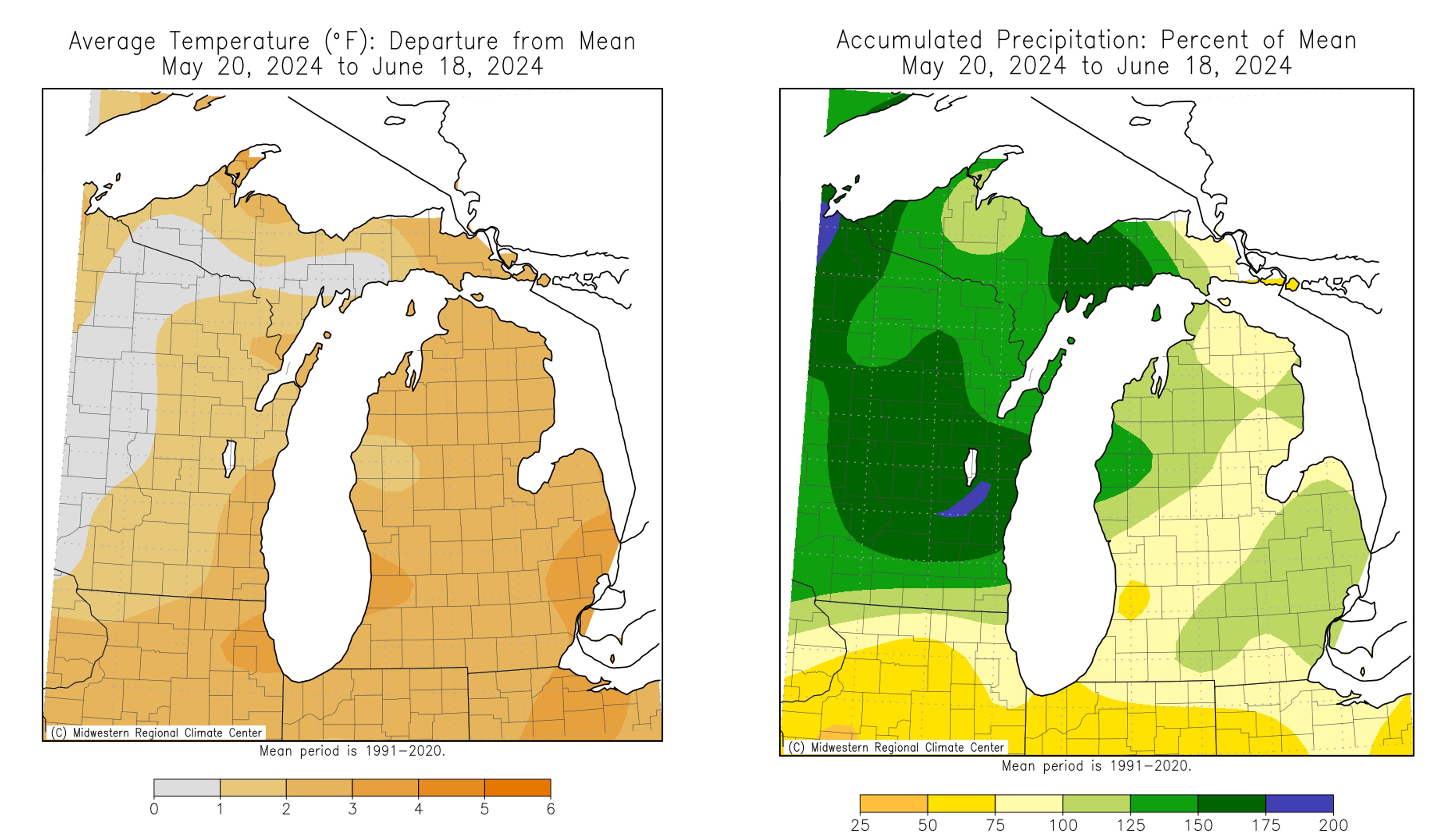
In terms of growing degree-day (GDD) accumulation (base 50 degrees Fahrenheit) from March 1, most areas of the state are still several days ahead of average.
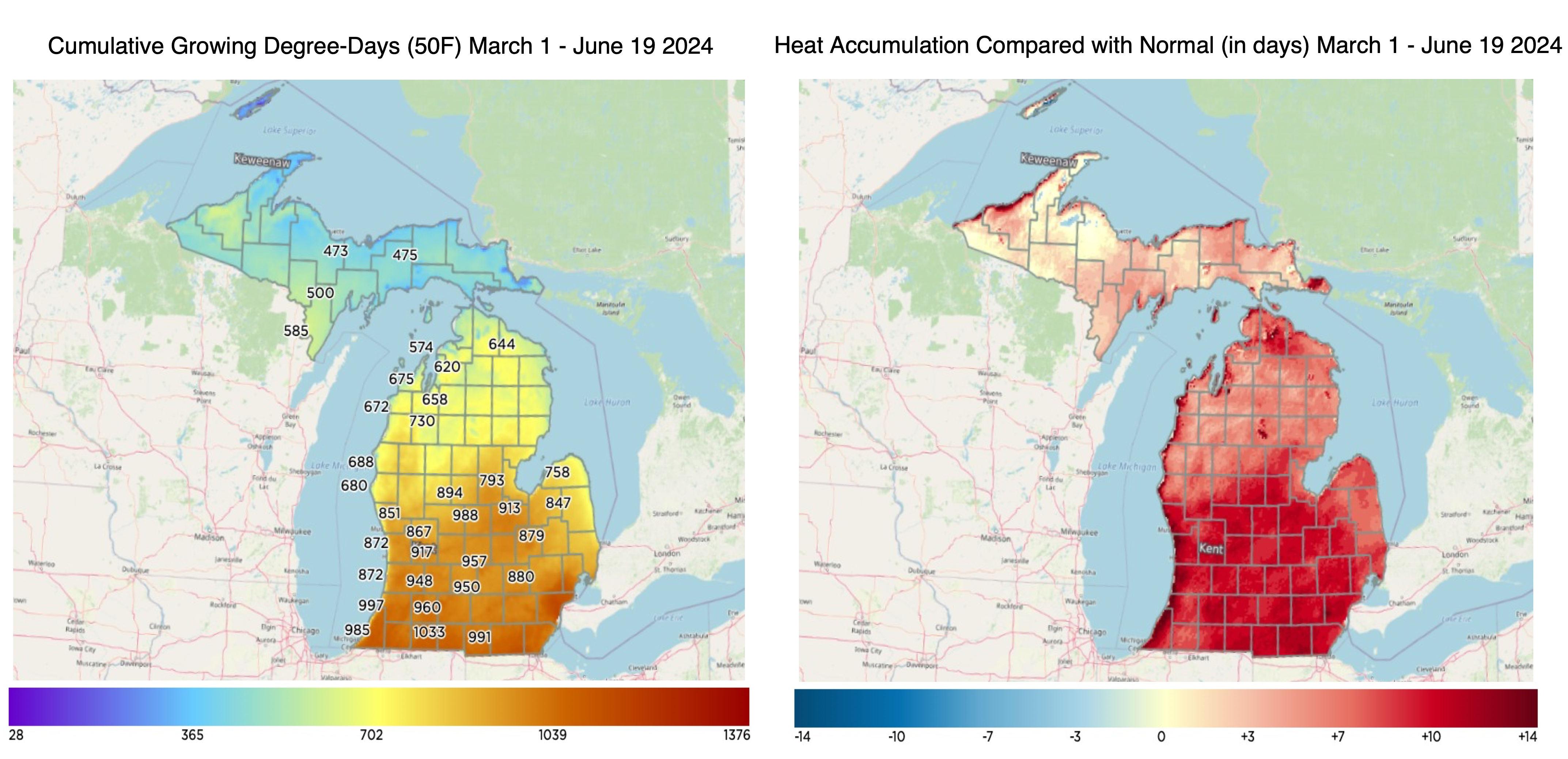
Looking ahead
Medium range guidance suggests warmer than normal temperatures and precipitation through the end of June.
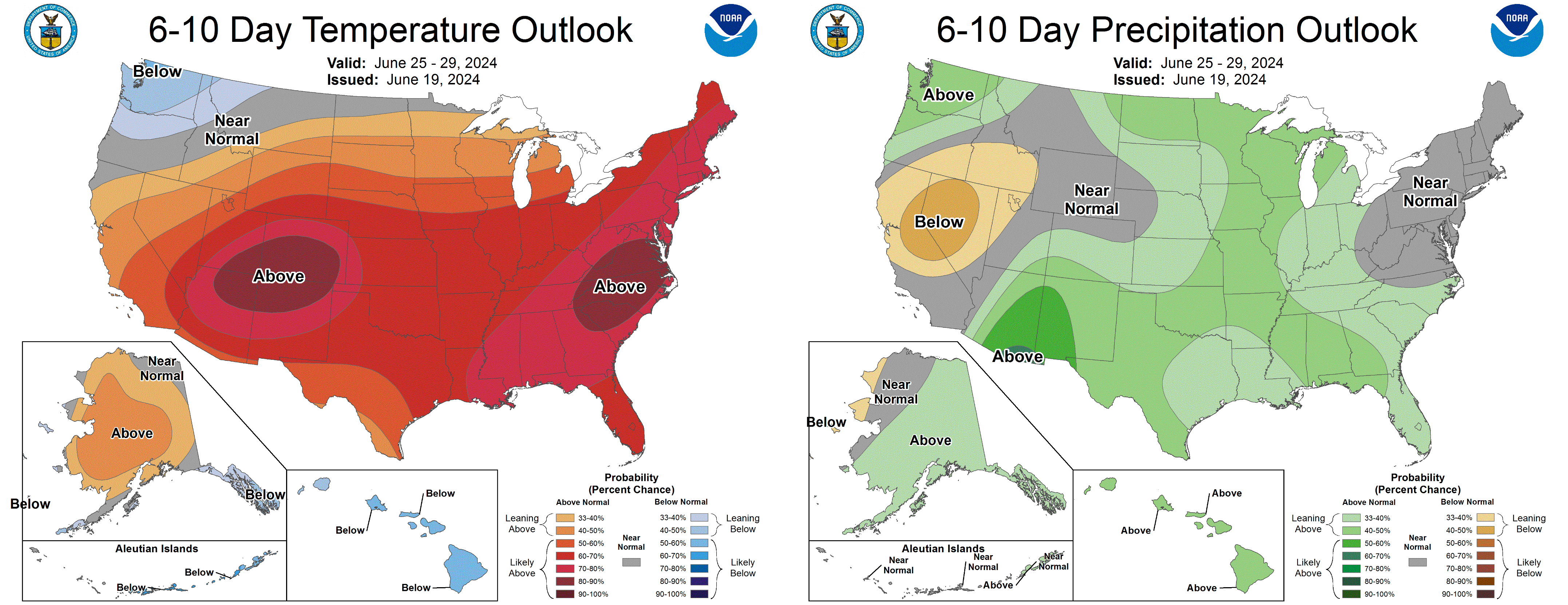
The extended forecast outlook for July, which was released June 20, suggests higher than normal temperatures and below average precipitation.
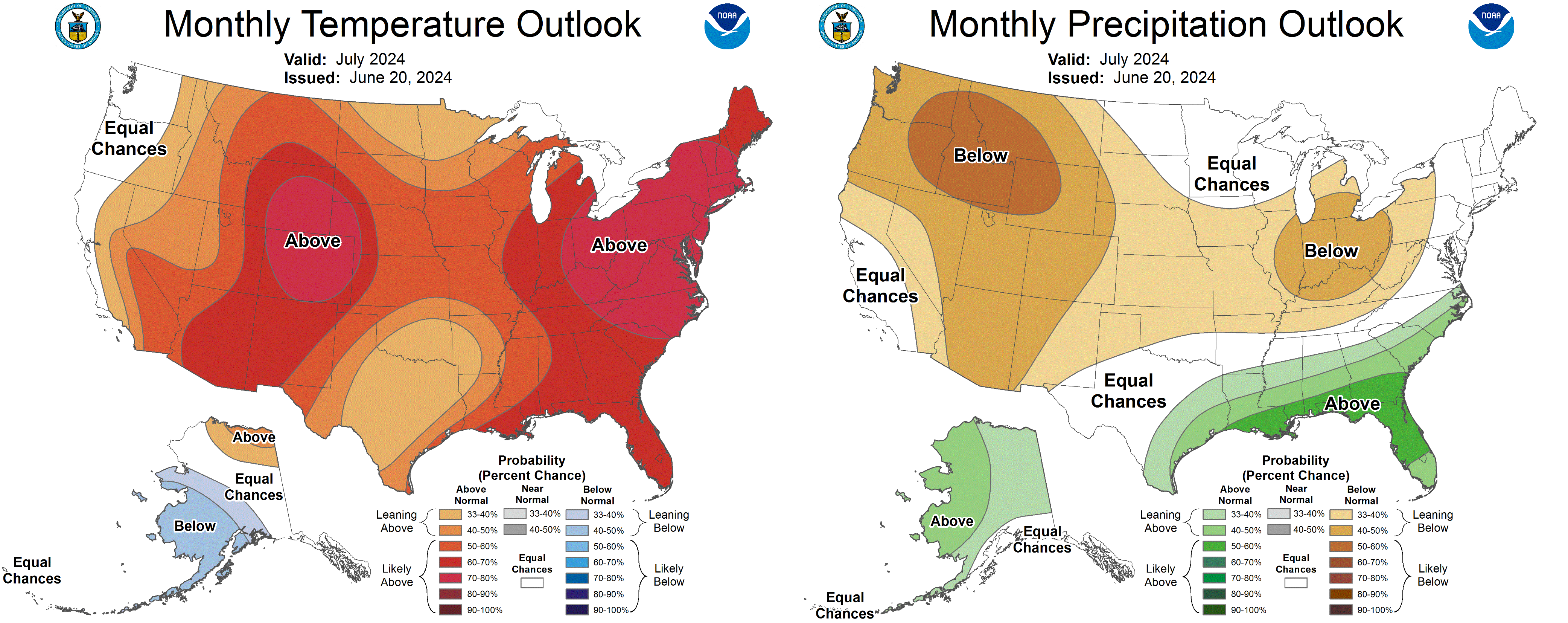
See the most recent Michigan State University agriculture weather forecast.
Management activities
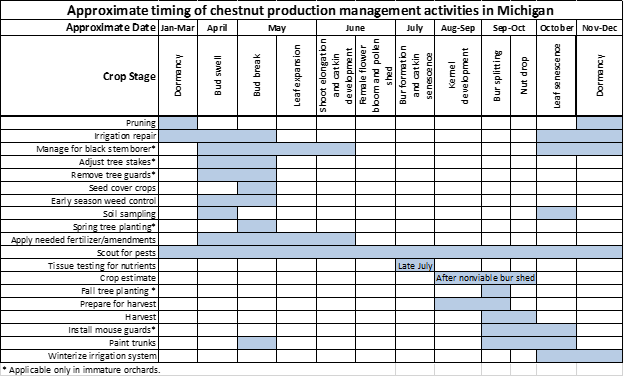
Fertility
The ideal window for using granular fertilizers is closing. You should be applying them soon if you have not already As a reminder, for nutrient management considerations, please reference the Michigan Chestnut Management Guide or the Nutrient Management section of the Michigan State University Extension Chestnuts website. To receive nutrient management recommendations from Michigan State University, pick up a commercial test at your local MSU Extension office.
Insect pests

The following is a summary of current pest related information for Michigan chestnut orchards. For more detailed information and additional images, please visit the pest management section on the MSU Extension Chestnuts website.
Asian chestnut gall wasp emergence could begin at any time. Adult emergence has typically been observed in late June or early July but given the early warm up, we may see them earlier than usual. Effective pest management starts with active scouting. Chestnut growers in counties west of Highway 127, especially areas south of I-96 in lower Michigan, should be scouting their trees for evidence of the Asian chestnut gall wasp during the growing season and again in fall or winter, after leaf drop.
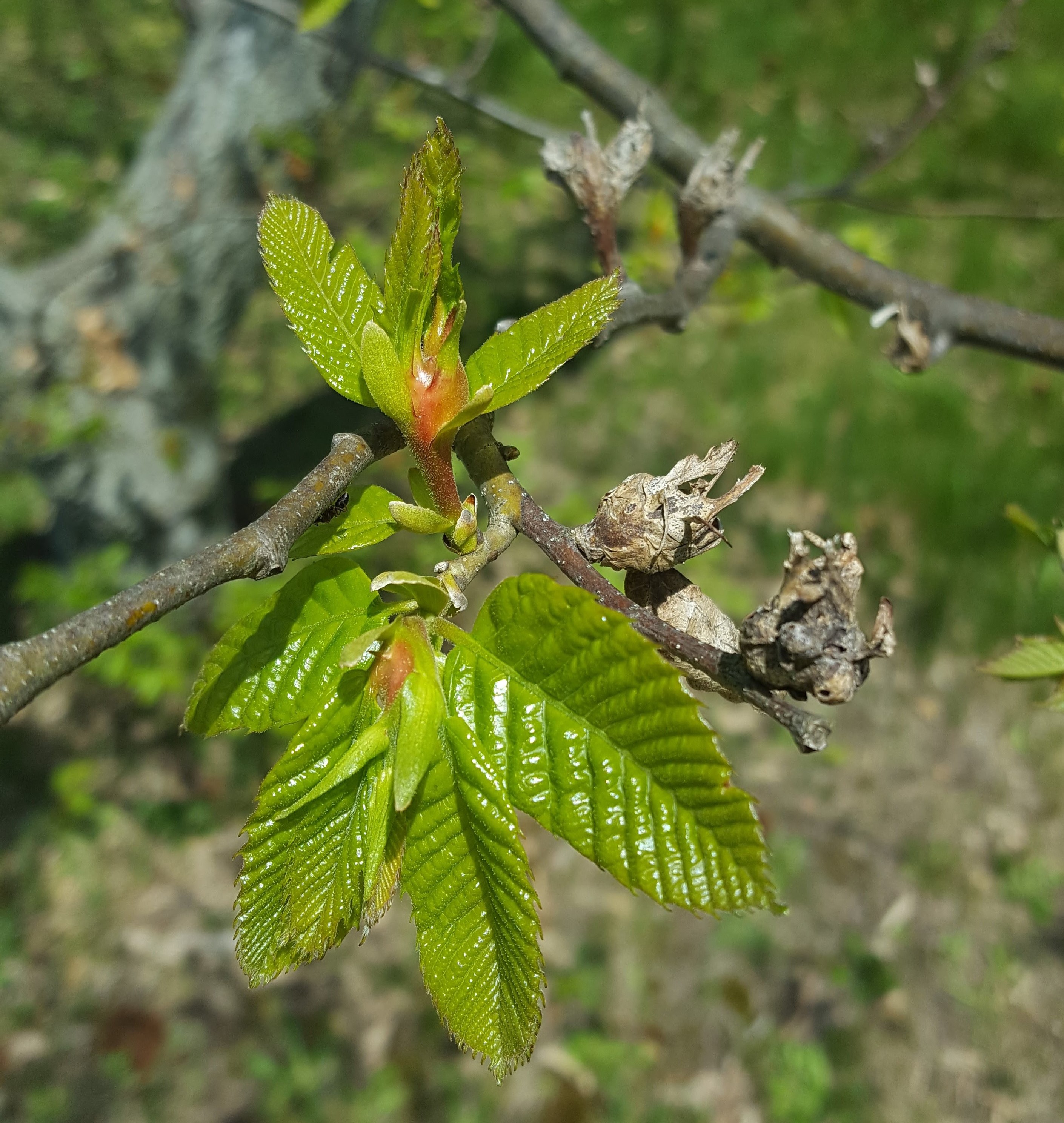
In late spring and summer, green or reddish galls can be observed on branches or leaves. In fall and winter, look for dried, brown galls on the shoots. Many old galls remain on the tree through winter and are more visible after leaves drop in fall. These old galls can remain attached to the trees for at least one or two years after the wasps have emerged.
Asian chestnut gall wasp produces one generation per year and is a parthenogenetic species, meaning all wasps are female and reproduction occurs asexually. Thus, even a single wasp can start a new infestation. Gall wasp adults are very small, about 1/8-inch (3 mm) long, and have black bodies with yellow legs. Adult wasps lay eggs inside chestnut buds over a four- to six-week period, typically from the last week of June to the second week in August in southwest Michigan. This period corresponds to approximately 1,050 to 2,100 cumulative growing degree days (GDD), using a threshold temperature of 50 degrees Fahrenheit (GDD50F) and a starting date of Jan. 1. Eggs hatch after about 40 days. The tiny larvae, which cannot be seen without magnification, remain dormant in the buds throughout the winter until the following spring.
Growers with young trees should carefully monitor for Asian chestnut gall wasp adult flight and consider applying a pyrethroid insecticide for control. Young trees are particularly susceptible to severe damage by Asian chestnut gall wasp due to the limited number of buds and the need to establish tree structure during the first years of establishment. Growers can hang yellow sticky traps in mid-late June in the canopy to passively trap for adult flight and better time pesticide applications. Growers with mature trees should monitor the impact of Asian chestnut gall wasp on yield and tree health and make management decisions accordingly.
For more information, check out the Asian Chestnut Gall Wasp bulletin.
Black stem borer flight continues, and growers should be protecting vulnerable trees. Black stem borer will infest and damage a wide variety of woody plant species, including chestnuts. Black stem borers are attracted to small trees with less than a 4-inch trunk diameter and stressed trees that produce ethanol. Female borers create tunnels in trunks to lay their eggs. These tunnels damage the tree’s ability to translocate water and nutrients.

Overwintering adults become active in late April or early May after one or two consecutive days of 68 F or higher, often coinciding with blooming forsythia and can continue through July.

Growers are encouraged to use a simple ethanol baited trap to monitor for activity starting in mid-April and continuing through the end of July. Traps should be placed near wooded areas adjacent to the orchard and at a height of 1.6 feet. Hand sanitizer is an easy and accessible bait but should be refreshed every few days. Traps can consist of just a pop bottle (or similar container) with around a 0.5-1 cup of hand sanitizer.
Growers with small, vulnerable trees and positive trap catches or a history of damage will need to apply a trunk spray to prevent damage. The time to spray an insecticide for this pest is when females are flying in the spring before colonizing new trees. Young trees near the perimeter of orchards, especially near woodlots, are at greatest risk of injury. Because they are so tiny, it is impossible to visually monitor for adults to determine the optimum time to apply an insecticide, so trapping as described above is recommended to detect adult activity and apply treatment.
Pyrethroid insecticides applied as trunk sprays have shown the most promise in reducing the number of new infestations within a season. For a list of registered pyrethroids for use in Michigan chestnuts, refer to the Michigan Chestnut Management Guide.
Later in the season, remove and burn any damaged dead or dying trees. It is also important to make sure all large prunings and brush piles are either burned, or chipped and composted as they may harbor overwintering adults and contribute to future infestations. For more information on black stem borer, refer to the Michigan State University Extension bulletin, “Managing Black Stem Borer in Michigan Tree Fruits.”
Japanese beetle adult emergence could begin at any time. Japanese beetle adults are considered a generalist pest and affect many crops found on or near grassy areas, particularly irrigated turf. Adult Japanese beetle emerges around early July and feeds on hundreds of different plant species, skeletonizing the tissue. If populations are high, they can remove all the green leaf material from the plants.
There are no established treatment thresholds or data on how much Japanese beetle damage a healthy chestnut tree can sustain, but consider that well-established and vigorous orchards will likely not require 100% protection. Younger orchards with limited leaf area will need to be managed more aggressively.
For more information on Japanese beetle, check out the pest management section of the chestnut webpage.
Potato leafhopper has arrived in Michigan a little earlier than usual. Like many plants, chestnuts are sensitive to the saliva of potato leafhopper, which is injected by the insect while feeding. Damage to leaf tissue can cause reduced photosynthesis, which can impact production and quality and damage the tree. Most injury occurs on new tissue on shoot terminals with potato leafhopper feeding near the edges of the leaves using piercing-sucking mouthparts. Symptoms of feeding appear as whitish dots arranged in triangular shapes near the edges. Heavily damaged leaves are cupped with brown and yellowed edges and eventually drop from the tree. Severely infested shoots produce small, bunched leaves with reduced photosynthetic capacity.

Adult leafhoppers are pale to bright green and about 1/8 inch long. Adults are easily noticeable, jumping, flying or running when agitated. The nymphs (immature leafhoppers) are pale green and have no wings but are very similar in form to the adults. Potato leafhopper move in all directions when disturbed, unlike some leafhoppers which have a distinct pattern of movement. The potato leafhopper can’t survive Michigan’s winter and survives in the Gulf States until adults migrate north in the spring on storm systems.
Scouting should be performed weekly as soon as leaf tissue is present to ensure early detection and prevent injury. More frequent spot checks should be done following rainstorms which carry the first populations north. For every acre of orchard, select 5 trees to examine and inspect the leaves on 3 shoots per tree (15 shoots per acre). The easiest way to observe potato leafhopper is by flipping the shoots or leaves over and looking for adults and nymphs on the underside of leaves. Pay special attention to succulent new leaves on the terminals of branches.
For more information on insecticides available for the treatment of potato leafhopper refer to the Michigan Chestnut Management Guide.
In 2022 and 2023, some growers reported higher than typical European red mite populations, so everyone should be on the lookout as early as possible. European red mites overwinter as eggs in bark crevices and bud scales and are the most commonly observed species in Michigan chestnut orchards. Eggs are small spheres, about the size of the head of a pin with a single stipe or hair that protrudes from the top (this is not always visible). Eggs can be viewed with a hand lens or the naked eye once you have established what you are looking for.
Scout for overwintering eggs and early nymph activity in the spring to assess population levels in the coming season. As temperatures warm, overwintering eggs hatch and nymphs move onto the emerging leaves and start feeding. Adult European red mite are red in color and have hairs that give them a spikey appearance. Adult and nymph feeding occurs primarily on the upper surface of the leaves. This first generation is the slowest of the season and typically takes a full three weeks to develop and reproduce. This slow development is due to the direct link between temperature and mite development. Summer generations, favored by the hot and dry weather, can complete their lifecycles much faster with as little as 10 days between generations under ideal conditions.
As you scout, remember that not all mites are bad. Consider documenting the levels of predacious mites in your orchard. If healthy populations of mite predators exist, they will continue to feed on plant parasitic eggs and nymphs and can be an effective component of your mite management program. Predaceous mites are smaller than adult European red mite and twospotted spider mite, but they can be seen with a hand lens and typically move very quickly across leaf surfaces.
Mite control starts with monitoring early in the spring looking for the overwintering eggs (European red mite) and assessing the mite pressure. Ideally, growers will be using limited insecticides with miticidal activity in their season long programs, as that protects their beneficial mite populations which help minimize pest mites. If pest mite populations are high enough to require control, superior oil application when the trees are dormant is an effective method of treatment. If issues with mites arise during the growing season, refer to the Michigan Chestnut Management Guide for control options.
Disease
Existing chestnut blight infections (caused by Cryphonectria parasitica) can be observed at this time. There are no commercially available treatments for chestnut blight. Growers may prune out infected branches or cull whole trees as needed to limit disease pressure. Infested material should be burned or buried to further limit inoculum spread. To learn more about chestnut blight, visit the pest management section of the chestnut webpage.
Growers should not be pruning chestnuts at this time as they are vulnerable to infection by not just chestnut blight but the oak wilt fungus as well.
Stay connected
For more information on chestnut production, visit www.chestnuts.msu.edu, sign up to receive our newsletter and join us for the free 2024 MSU Chestnut Growers Chat Series.
If you are unsure of what is causing symptoms in the field, you can submit a sample to MSU Plant & Pest Diagnostics. Visit the webpage for specific information about how to collect, package, ship and image plant samples for diagnosis. If you have any doubt about what or how to collect a good sample, please contact the lab at 517-432-0988 or pestid@msu.edu.
Become a licensed pesticide applicator
All growers utilizing pesticide can benefit from getting their license, even if not legally required. Understanding pesticides and the associated regulations can help growers protect themselves, others and the environment. Michigan Pesticide Applicator Certification is administered by the Michigan Department of Agriculture and Rural Development. You can read all about the process by visiting the Pesticide FAQ webpage. Michigan State University offers a number of resources to assist people pursuing their license, including an online study/continuing educational course and study manuals.
This work is supported by the Crop Protection and Pest Management Program [grant no 2021-70006-35450] from the USDA National Institute of Food and Agriculture. Any opinions, findings, conclusions, or recommendations expressed in this publication are those of the author(s) and do not necessarily reflect the view of the U.S. Department of Agriculture.



 Print
Print Email
Email




